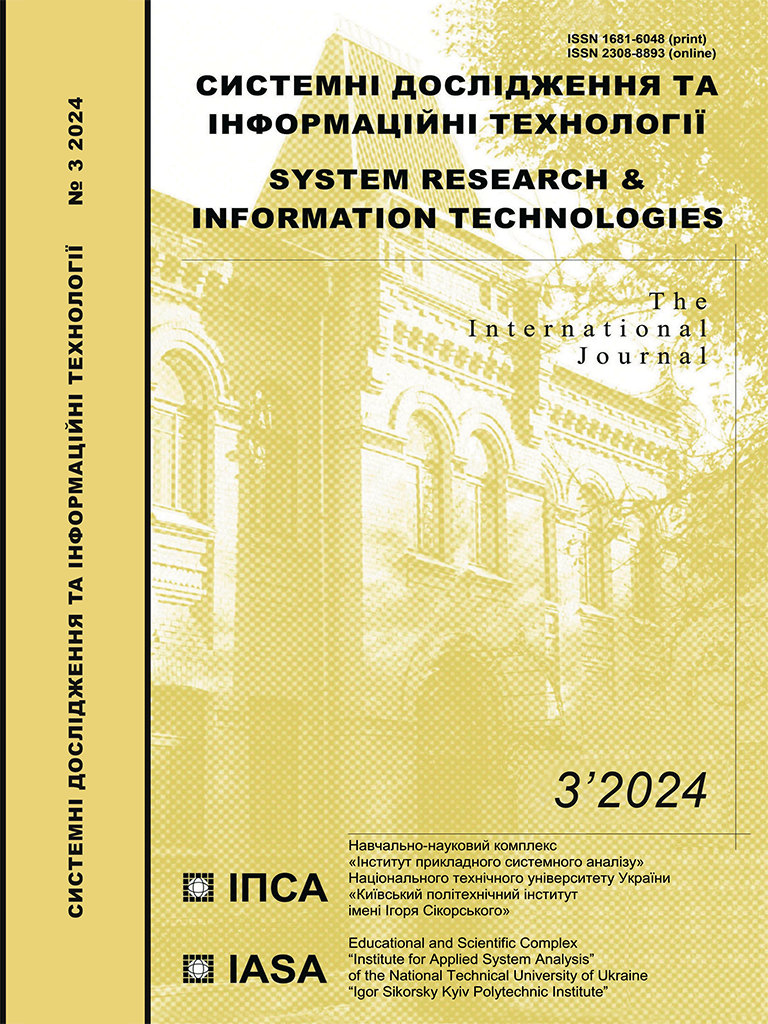Identification of nonlinear systems with periodic external actions (Part I)
DOI:
https://doi.org/10.20535/SRIT.2308-8893.2024.3.06Keywords:
identification, ordinary differential equation, external action, periodic coefficient, constant coefficientAbstract
The problem of identifying nonlinear systems with periodic external actions is considered in the article. The number of such actions in the system is not limited, and these actions can be either additive or multiplicative. We use a time series of observed system variables to calculate unknown equation coefficients. The proven theorem allows us to separate the unknown coefficients of the system into variables and constants. The proposed computational procedure allows us to avoid possible errors caused by the discrete nature of observable time series. Identification of zero coefficients is carried out in two ways, eliminating erroneous zeroing of the terms of the equations. The method is illustrated with a numerical example of identifying a chaotic system with periodic external actions.
References
T. Caraballo, X. Han, and P. Kloeden, “Chemostats with time-dependent inputs and wall growth,” Appl. Math. & Inf. Sci., vol. 9, no. 5, pp. 2283–2296, 2015. doi: 10.12785/amis/090509
Z. Zhang, S. Dey, and A. Singh, “Role of periodic forcing on the stochastic dynamics of a biomolecular clock,” European Control Conference (ECC), pp. 824–829, 2021. doi: 10.23919/ECC54610.2021.9654892
P.L. Gong, J.X. Xu, “Global dynamics and stochastic resonance of the forced Fitz-Hugh–Nagumo neuron model,” Phys. Rev. E, vol. 63, article no. 031906, 2001. doi: 10.1103/PhysRevE.63.031906
J.P. Tripathi, V. Tiwari, and S. Abbas, “A non-autonomous ecological model with some applications,, in Progress in Advanced Computing and Intelligent Engineering, Advances in Intelligent Systems and Computing, vol. 714, pp. 557–563, 2018. doi: 10.1007/978-981-13-0224-4_50
M. Martcheva, “A non-autonomous multi-strain SIS epidemic model,” J. Biol. Dyn., vol. 3, no. 2-3, pp. 235–251. doi: 10.1080/17513750802638712
J. Wang, H. Wang, and T. Wang, “External periodic force Control of a single-degree-of-freedom vibroimpact system,” J. Cont. Sci. Eng., vol. 2013, article no. 570137. doi: 10.1155/2013/570137
S. Zhou, G. Song, M. Sun, and Z. Ren, “Nonlinear dynamic analysis of a quarter vehicle system with external periodic excitation,” Int. J. Non-Lin. Mech., vol. 84, pp. 82–93, 2016. doi: 10.1016/j.ijnonlinmec.2016.04.014
Y. Ueda, “Randomly transitional phenomena in the system governed by Duffing’s equation,” J. Stat. Phys., vol. 20, pp. 181–196, 1979. doi: 10.1007/BF01011512
M. Hasler, “Electrical circuit with chaotic behavior,” Proc. IEEE, vol. 75, no. 8, pp. 1009–1021, 1987. doi: 10.1109/PROC.1987.13846
H.L. Smith, X.Q. Zhao, “Dynamics of a periodically pulsed bio-reactor model,” J. Diff. Equ., vol. 155, pp. 368–404, 1999. doi: 10.1006/jdeq.1998.3587
X.N. Liu, L.S. Chen, “Global dynamics of the periodic logistic system with periodic impulsive perturbations,” J. Math. Anal. Appl., vol. 289, pp. 279–291, 2004. doi: 10.1016/j.jmaa.2003.09.058
P.E. Kloeden, M. Rasmussen, “Nonautonomous dynamical systems,” Mathematical Surveys and Monographs, vol. 176. Providence, Rhode Island: American Mathematical Society, 2011. doi: 10.1090/surv/176
P.E. Kloeden, C. Potzsche, Nonautonomous dynamical systems in the life sciences,” Lecture Notes in Mathematics, vol. 2102, pp. 3–39, 2013. doi: 10.1007/978-3-319-03080-7_1
A. Chithra, I.R. Mohamed, “Multiple attractors and strange nonchaotic dynamical behavior in a periodically forced system,” Nonl. Dyn., vol. 105, pp. 3615–3635, 2021. doi: 10.1007/s11071-021-06608-8
A. Tarantola, Inverse problem theory and methods for model parameter estimation. Philadelphia: Society for Industrial and Applied Mathematics, 2005. doi: 10.1137/1.9780898717921
R. Yoon R, H.S. Bhat, and B. Osting, “A non-autonomous equation discovery method for time signal classification,” SIAM J. Appl. Dyn. Sys., vol. 21, no. 1, pp. 33–59, 2022. doi: 10.1137/21M1405216
O. Schön, R.S. Götte, and J. Timmermann, “Multi-objective physics-guided recurrent neural networks for identifying non-autonomous dynamical systems,” IFAC-Papers-OnLine, vol. 55(12), pp. 19–24, 2022. doi: 10.1016/j.ifacol.2022.07.282
M. Cenedese, J. Axås, B. Bäuerlein, K. Avila, and G. Haller, “Data-driven modeling and prediction of non-linearizable dynamics via spectral submanifolds,” Nature Commun., vol. 13, article no. 872, 2022. doi: 10.1038/s41467-022-28518-y
T.S. Jang, H. Baek, H.S. Choi, and S.G. Lee, “A new method for measuring nonharmonic periodic excitation forces in nonlinear damped systems,” Mech. Syst. Sign. Proc., vol. 25, no. 6, pp. 2219–2228, 2011. doi: 10.1016/j.ymssp.2011.01.012
B.P. Bezruchko, D.A. Smirnov, “Constructing nonautonomous differential equations from a time series,” Phys. Rev. E, vol. 63, article no. 016207, 2001. doi: 10.1103/PhysRevE.63.016207
T. Sauer, “Observing periodically forced systems of difference equations,” J. Difference Equ. Appl., vol. 16, no. 2–3, pp. 269–273, 2010. doi: 10.1080/10236190902870439
E. Glasner, B. Weiss, “Sensitive dependence on initial conditions,” Nonlinearity, vol. 6, no. 6, article no. 1067, 1993. doi: 10.1088/0951-7715/6/6/014
G. Strang, Linear algebra and its applications. New York, USA: Academic Press, 1976.
O.E. Rössler, “An equation for continuous chaos,” Phys. Lett. A, vol. 57, no. 5, pp. 397–398, 1976. doi: 10.1016/0375-9601(76)90101-8
M. Wang et al., “Fundamental limits and optimal estimation of the resonance frequency of a linear harmonic oscillator,” Commun. Phys., vol. 4, article no. 207, 2021. doi: 10.1038/s42005-021-00700-6

